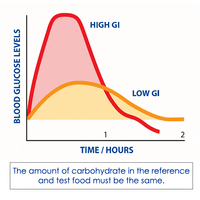Dietary Carbohydrate
Primary role of dietary Carbohydrates: provide energy
4 cal/g
Classification
Simple sugars
monosaccharides
disaccharides
Complex sugars
polysaccharides
Fibers
Monosaccharides
Principal monosaccharides found in food:
glucose: fruits, sweet corn, corn syrup, honey
fructose: found with free glucose in honey and fruits (e.g. apples)
High-fructose corn syrup (HFCS)
corn syrup that has undergone enzymatic processing to convert their glucose into fructose and have been mixed with pure corn syrup (100% glucose) to produce a desired sweetness
HFCS 55 (55% fructose and 42% glucose): substitute for sucrose on beverages (e.g. soft drinks)
HFCS 42 used in processed foods
composition of HFCS and surcose are similar
major difference: HFCS is ingested as a mixture of monosaccharides
no significant difference in either postprandial glucose or insulin responses
Disaccharides
Most abundant:
sucrose: table sugar
glucose + fructose
lactose: principal sugar found in milk
glucose + galactose
maltose: product of enzymatic digestion of polysaccharides, found in beer and malt liquors
glucose + glucose
Polysaccharides
complex carbohydrates
most often polymers of glucose
do not have a sweet taste
Sources: starch, wheat, potatoes, dried peas, beans (legumes) and vegetables
Fiber
Dietary fiber: non-digestible, non-starch carbohydrates and lignin present in plants
soluble fiber is the edible part of plants
resistant to digestion and absorption in the human small intestine
insoluble fiber passes through the digestive track largely unchanged
provides little energy
Recommended intake (AI) for total fiber:
25 g/day for women
38 g/day for men
Type of Fiber | Major Source in Diet | Chemical Properties | Physiological Effects |
|---|---|---|---|
Cellulose | Unrefined cereals, bran, whole wheat | Nondigestible, water insoluble, absorbs water | Stool bulk, intestinal transit time, intracolonic pressure |
Hemicellulose | Unrefined cereals, some fruits and vegetables, whole wheat | Partially digestible, usually water insoluble, absorbs water | Stool bulk, intestinal transit time, intracolonic pressure |
Lignin | Woody part of vegetables | Nondigestible, water insoluble, absorbs organic substances | Stool bulk, binds cholesterol, binds carcinogens |
Pectin | Fruits | Digestible, water soluble, mucilaginous | Rate of gastric emptying,Rate of sugar uptake, Serum cholesterol |
Gums | Dried beans, oats | Digestible,water soluble, mucilaginous | Serum cholesterol, Rate of gastric emptying,Rate of sugar uptake |
Benefits
adds bulk to diet
increasing bowel mobility during exposure of intestines to carcinogens
promoting bowel movements (laxation)
softens stool: decrease risk for constipation, hemorrhoids, and diverticulosis
soluble fiber:
delays gastric emptying
which can result in a sensation of fullness (satiety)
reduce spikes in blood glucose following a meal
lower plasma LDL-C levels by increasing fecal bile acid excretion and interfering with bile acid reabsorption
Dietary Carbohydrate and Blood Glucose
carbohydrates differ in their glycemic response (GR)
carbohydrate-containing foods produce either
rapid rise followed by a steep fall in blood glucose
gradual rise followed by a slow decline in blood glucose
Glycemic index (GI): the area under the blood glucose curve seen after ingestion of meal with carbohydrate-rich food, compared with the area under the blood glucose curve observed after a meal consisting of the same amount of carbohydrate in the form of glucose or white bread.
low GI: <50
high GI: ≥70
low-GI diet improves glycemic control in diabetic individuals
foods with low GI tend to create a sense of satiety over a long period of time
helpful in limiting caloric intake

Carbohydrate Requirements
not essential nutrients
absence of dietary carbohydrate leads to ketogenesis
RD for for carbohydrate: 130 g/day for adults and children
adults should consume 45% - 65% of their total calories from carbohydrates
added sugars should represent no more than 10% of total energy intake
 Knowt
Knowt
